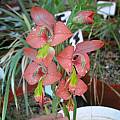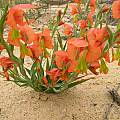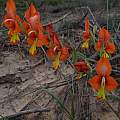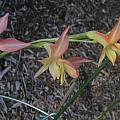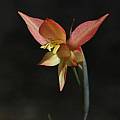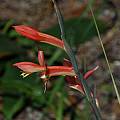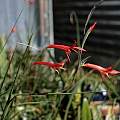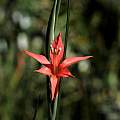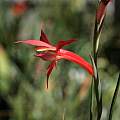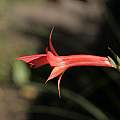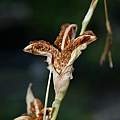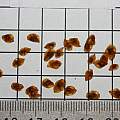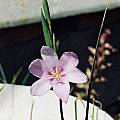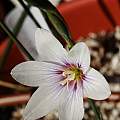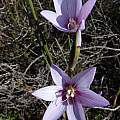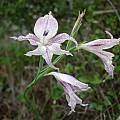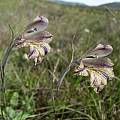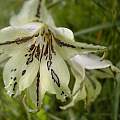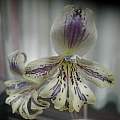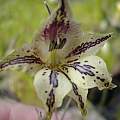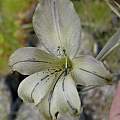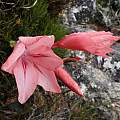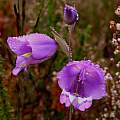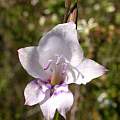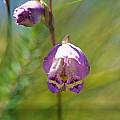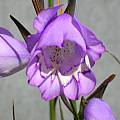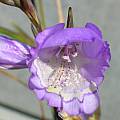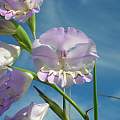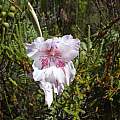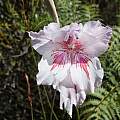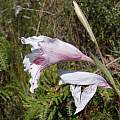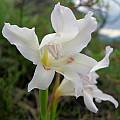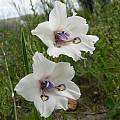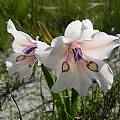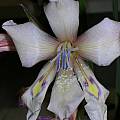Winter rain Gladiolus like their winters wet and mild and may need a dry summer dormancy. They are often less hardy, reaching down to USDA zone 8 at most.
Page 1: G. abbreviatus... Page 2: G. bonaspei... Page 3: G. carmineus... Page 4: G. debilis... Page 5: G. gracilis... Page 6: G. inflatus... Page 7: G. maculatus... Page 8: G. mutabilis... Page 10: G. saccatus... Page 11: G. teretifolius...
Gladiolus pulcherrimus (G.J.Lewis) Goldblatt & J.C.Manning has very striking orange to salmon flowers that are similar to Gladiolus alatus but is distinguished by broad sword shaped leaves that lack prominent veins. It grow in the northwest Cape on sandstone slopes. This one, grown by Gordon Summerfield in South Africa, was blooming September 2003. Photos by Bob Rutemoeller, Alan Horstmann, and Rod Saunders.
Gladiolus quadrangularis (Burm.f.) Ker Gawl. (syn. Homoglossum quadrangulare) is found on rocky sandstone slopes in the Northwest Cape. It has 4 to 10 red to orange flowers and blooms late winter into spring. Photos 1-3 were taken by Mary Sue Ittner showing plants that bloomed in Northern California March 2004 and 2007.
The photos below were taken by Nhu Nguyen. The seeds are on a 1 cm grid.
Gladiolus quadrangulus (D.Delaroche) Barnard (syn. Ixia linearis, G. linearis, G. biflorus) is found in the southwestern Cape in sandy soil in seasonally wet, poorly drained and sometimes brackish habitat. Goldblatt & Manning report that it has been eliminated from most of its original range, and that "its long-term survival in the wild is unlikely." Fortunately, it is relatively easy to grow in cultivation, where it can be treated like a typical winter-growing Glad. It has pale pink, mauve or white flowers. The tepals have darker veins. It blooms late winter into spring. The shape of the flowers is reminiscent of an Ixia, and unlike most Gladiolus it does not produce nectar. Goldblatt & Manning speculate that it is adapted to pollination by pollen-eating insects. First photo by Alan Horstmann. Second photo by Michael Mace of a plant whose name tag was lost, but which is almost certainly G. quadrangulus. The final photo was taken by Rachel Saunders who photographed it in the wild.
Gladiolus recurvus Linnaeus occurs in shale derived soils from Ceres to Bredasdorp and flowers from June to October depending on the elevation. The fragrant flowers are pale gray to cream, yellowish or pinkish with purple lines and dots on the lower tepals and sometimes spotted or lined in the midline on the upper tepals as well. The first two photos were taken by Cameron McMaster in the Overberg. The other photos by Dirk Wallace show variation in the markings on flowers.
Gladiolus rhodanthus J.C. Manning & Goldblatt is distributed on rocky sandstone slopes at high elevations in the southwest Cape. Growing from 30 to 50 cm, it has hairy linear leaves and pink flowers with red markings on the lower tepals. Photo by Rachel Saunders taken with some effort since it was quite a climb (in light rain/mist) to get to it. It was growing at 1700 m in cracks in the cliffs.
Gladiolus rogersii Baker grows to 60 cm and has narrow leaves with a prominent midrib. Flowers are blue to purple with yellow or white transverse markings on the lower tepals. In the Kammanassie Mountains flowers can be cerise-pink. This is a widespread South African species found on sandstone and limestone slopes in winter and year round rainfall areas and mostly blooms in spring. There are variants that flower from autumn to early winter on the foothills of the mountains in the Little Karoo. The first two photos and information from the book Plants of the Klein Karoo courtesy of Jan and Anne Lise Schutte-Vlok. The third photo by Mary Sue Ittner was taken of a plant growing on a slope east of Swellendam. Most of the flowers had been eaten by an insect. Photos 4-6 were taken by Alan Horstmann.
Gladiolus roseovenosus Goldblatt & Manning is a rare winter rainfall species that grows in peaty sandstone soil on well drained slopes in the coastal foothills of the Outeniqua Mountains in the southern Cape. Plants grow 20 to 40 cm high and the long tubed creamy pink unscented flowers with red nectar guides are in a 2 to 4 flowered spike. Blooming time is summer into fall, between February and April. Photos taken by Rachel Saunders.
Gladiolus rudis Licht. ex Roem. & Schult. grows on sandstone slopes in fynbos in the southwestern Cape and blooms in spring. It has 2 to 5 cream to pale pink flowers on a spike. The lower tepals have spear-shaped markings and the perianth tube is funnel shaped. The first three photos taken by Cameron McMaster near Caledon and Fairfield in the Overberg and the last taken by Alan Horstmann.
Page 1: G. abbreviatus... Page 2: G. bonaspei... Page 3: G. carmineus... Page 4: G. debilis... Page 5: G. gracilis... Page 6: G. inflatus... Page 7: G. maculatus... Page 8: G. mutabilis... Page 10: G. saccatus... Page 11: G. teretifolius...
